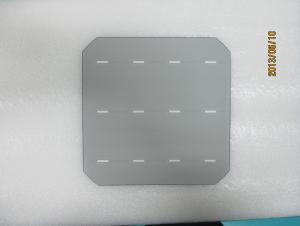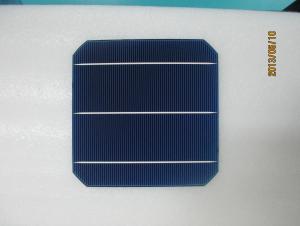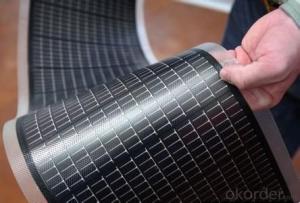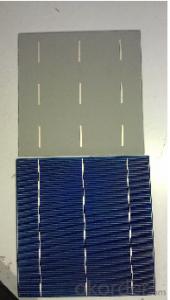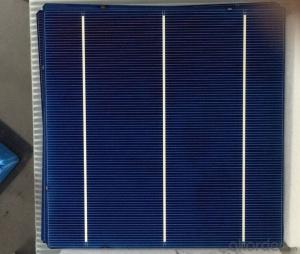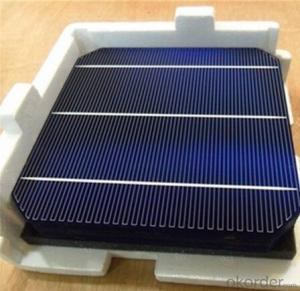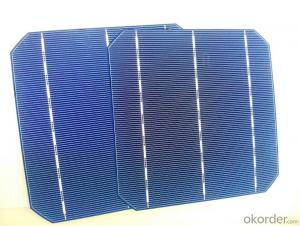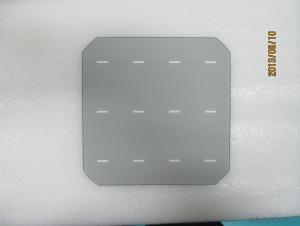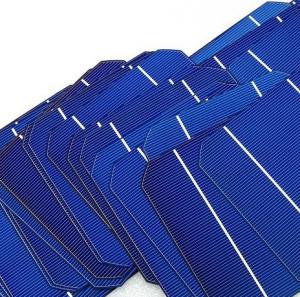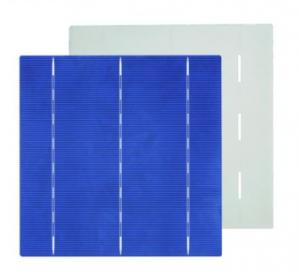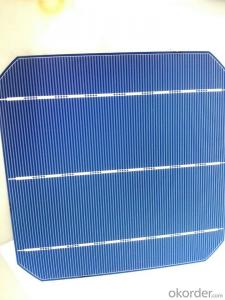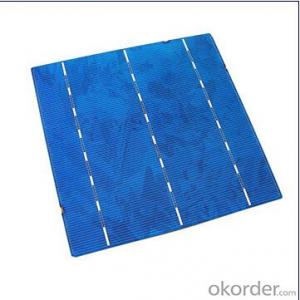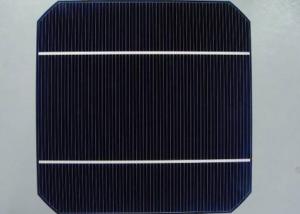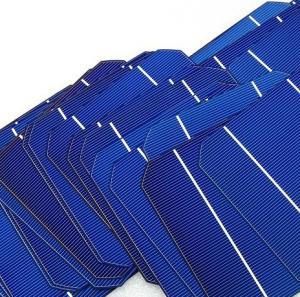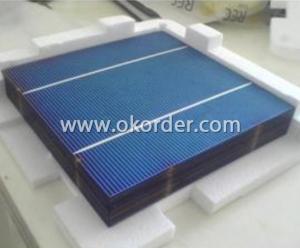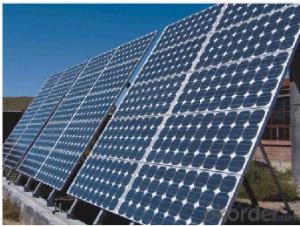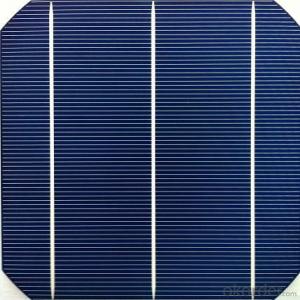Tabbed Solar Cells - Mono Solar Cells 156*156mm with 17.8% Efficiency
- Loading Port:
- China Main Port
- Payment Terms:
- TT or LC
- Min Order Qty:
- -
- Supply Capability:
- 1000000 pc/month
OKorder Service Pledge
OKorder Financial Service
You Might Also Like
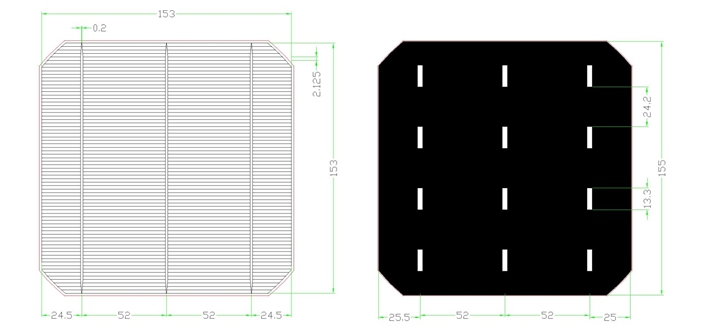
Monocrystal solar energy cell
type:156M
appearance:156×1565㎜±0.5mm;diagonal:R=100mm
Main fence wide:1.5mm back electrode wide:2.8mm
Fence line qty:90
Cell thickness:220![]() ±20
±20![]()
Eff(%) | 17.70- 17.80 | 17.80- 17.90 | 17.90- 18.00 | 18.00- 18.10 | 18.10- 18.20 | 18.20- 18.30 | 18.30- 18.40 | 18.40- 18.50 | 18.50- 18.60 | 18.60- 18.70 | 18.70- 18.80 | 18.80- 18.90 |
Pm(W) | 4.23 | 4.25 | 4.28 | 4.30 | 4.33 | 4.35 | 4.37 | 4.40 | 4.42 | 4.44 | 4.47 | 4.49 |
Isc(A) | 8.68 | 8.69 | 8.70 | 8.71 | 8.73 | 8.76 | 8.77 | 8.78 | 8.82 | 8.83 | 8.85 | 8.86 |
Im(A) | 8.13 | 8.15 | 8.17 | 8.19 | 8.21 | 8.24 | 8.26 | 8.30 | 8.33 | 8.35 | 8.39 | 8.42 |
Voc(V) | 0.626 | 0.627 | 0.628 | 0.630 | 0.631 | 0.632 | 0.633 | 0.634 | 0.634 | 0.635 | 0.636 | 0.637 |
Vm(V) | 0.522 | 0.523 | 0.525 | 0.527 | 0.528 | 0.529 | 0.531 | 0.531 | 0.532 | 0.534 | 0.534 | 0.535 |
FF(%) | 78.1 | 78.3 | 78.5 | 78.6 | 78.7 | 78.8 | 79.0 | 79.2 | 79.3 | 79.5 | 79.6 | 79.8 |

Factory Picture of Solar Cells
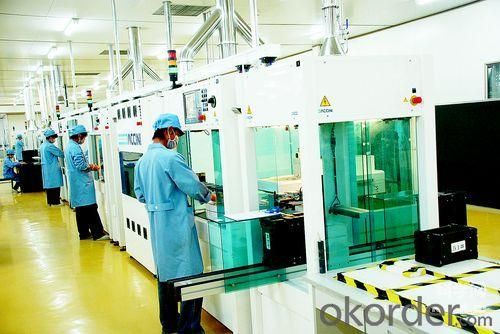
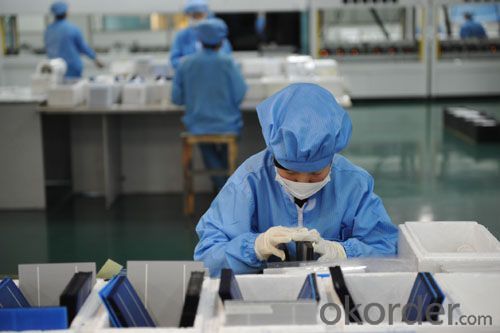
FAQ
We have organized several common questions for our clients,may help you sincerely:
What’s price per watt?
A: It’s depends on the quantity, delivery date and payment terms of the order. We can talk further about the detail price issue. Our products is high quality with lower price level.
Can you tell me the parameter of your solar cells?
We have different series of cells with different power output, both from c-si to a-si. Please take our specification sheet for your reference.
How do you pack your products?
We have rich experience on how to pack the panels to make sure the safety on shipment when it arrives at the destination.
Can you do OEM for us?
Yes, we can.
How long can we receive the product after purchase?
In the purchase of product within three working days, We will arrange the factory delivery as soon as possible. The perfect time of receiving is related to the state and position of customers. Commonly 7 to 10 working days can be served.
- Q: Can solar cells be used for powering concert venues?
- Yes, solar cells can be used for powering concert venues. Solar panels can be installed on the rooftops or surrounding areas of the venue to harness sunlight and convert it into electricity. This renewable energy source can help reduce reliance on traditional power grids and decrease carbon emissions associated with concert operations. While the size and capacity of the solar system would depend on the energy needs of the venue, it is a viable option for powering concert venues in a sustainable and environmentally friendly manner.
- Q: Can solar cells be used for lighting?
- Yes, solar cells can be used for lighting. Solar cells convert sunlight into electricity, which can be used to power lighting systems. This can be done by directly connecting the solar cells to the lighting fixtures or by storing the generated electricity in batteries for later use. Solar-powered lighting systems are environmentally friendly and can be a cost-effective solution for outdoor lighting, street lighting, and even indoor lighting in areas with limited access to electricity.
- Q: Can solar cells be used to power remote data collection systems?
- Yes, solar cells can be used to power remote data collection systems. Solar cells are a reliable and sustainable source of energy that can convert sunlight into electricity. They can be installed in remote locations where access to the power grid is limited or unavailable, providing a practical solution for powering data collection systems. Additionally, solar cells can be combined with batteries to store excess energy for use during periods of low sunlight, ensuring continuous power supply for remote data collection systems.
- Q: How do solar cells handle dust storms or sandstorms?
- Solar cells are designed to withstand dust storms or sandstorms by incorporating protective measures. The surface of solar panels is typically made of tempered glass or other durable materials that can resist scratches or damage caused by blowing dust or sand. Additionally, the panels are often tilted or installed at an angle, allowing the wind to blow away any accumulated dust. Regular cleaning and maintenance are also carried out to ensure optimal performance in dusty conditions.
- Q: Can solar cells be used to power outdoor lighting systems?
- Yes, solar cells can be used to power outdoor lighting systems. Solar cells, also known as photovoltaic cells, convert sunlight into electricity. This electricity can be stored in batteries or used directly to power outdoor lighting systems, eliminating the need for traditional electrical wiring or reliance on grid electricity. Solar-powered outdoor lighting systems are efficient, cost-effective, and environmentally friendly solutions for illuminating outdoor spaces.
- Q: What are the applications of solar cells?
- oil, marine, meteorological fields: oil pipelines and reservoir gates cathodic protection solar power systems, oil drilling platform life and emergency power, marine testing equipment, weather / hydrological observation equipment. (
- Q: How do solar cells perform in regions with high levels of snowfall and blizzards?
- Solar cells typically do not perform well in regions with high levels of snowfall and blizzards. The accumulation of snow on the solar panels can block sunlight from reaching the cells, significantly reducing their efficiency. However, some solar systems are designed with a tilt or heating elements to help shed snow or melt it off the panels. Additionally, periodic maintenance and cleaning may be required to ensure optimal performance in these conditions.
- Q: Can the solar powered cells really work better than the normal cells?
- Yes, of course, the solar powered cells are much better than the normal cells, not only it functions better but also because it can save much more ebergy while proving more energy.
- Q: How does the solar cell work properly?
- The material which is used to absorb the energy from sunshine should be silicon.
- Q: Can solar cells be used to power remote sensing devices?
- Yes, solar cells can be used to power remote sensing devices. Solar cells convert sunlight into electricity, which can then be used to power various electronic devices including remote sensing devices. This eliminates the need for traditional power sources or batteries, making solar cells a reliable and sustainable option for powering remote sensing devices in locations where access to electricity may be limited or impractical.
Send your message to us
Tabbed Solar Cells - Mono Solar Cells 156*156mm with 17.8% Efficiency
- Loading Port:
- China Main Port
- Payment Terms:
- TT or LC
- Min Order Qty:
- -
- Supply Capability:
- 1000000 pc/month
OKorder Service Pledge
OKorder Financial Service
Similar products
Hot products
Hot Searches
Related keywords
